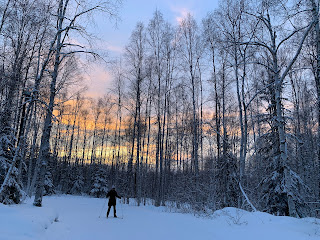T minus 3 weeks until I leave for the frozen north. Today in Fairbanks, the high is -15°F and the low is -25. Things change rapidly, but that's how I expect it will be most of the time while I'm there. Hopefully everything goes off without a hitch. (If there's a hitch, it's a big hitch, i.e. Omicron.) To boost those chances, the team has an official song and dance to "summon the aurora" and ensure mission success. It's no banana, but it could help.
A little rumination about the dark.
I don't think I talked about this back during my Norway travels, but if you don't see the Sun for a couple weeks, it changes you. In 2010, I traveled to Svalbard (an archipelago far north of mainland Norway) for the RENU rocket launch and didn't see the Sun for two and a half weeks. Up there, in the winter, there is no dawn, no peeking over the horizon, just darkness. The sky gets a tiny bit lighter during the middle of the "day" - say the difference between nightfall and full-on night (slight distinction). It was weird and psychologically rough. When I flew off-island on the way home and landed in Tromsø (the Paris of the north!) and saw the Sun rise for the first time in 18 days, I had a near-religious experience. It made me want to compose an epic poem to a Sun God. Or fall on my knees and wail. Instead I think I quietly cried while staring at the Sun long enough that the words "retinal damage" surfaced in my mind. At a time like that, you really get the obsession of ancient cultures with the Sun, the deification, all of it. The Sun is life.
On the other side of that - sunlight 24 hours a day, which I experienced in the Antarctic summer - it's not such a big deal. You pull the blackout curtains at night, lower the lights, and hang out like you would in the evenings at home. If you venture outside in the middle of the night into the blinding light, it's a bit of a shock, but doesn't mess with your mental state in the same way as no sun. There's not the visceral attachment to the night, as with the daylight.
Which seemed odd to me, since I've always preferred the night to the day. Given a choice, I'll take the darkness of night over the daylight almost anytime. In high school and through college, all I wanted was to stay up all night and sleep all day. Funny that it's still the sunlight that is most necessary. Something baked into our reptile brains, for sure.
So. Into the dark once more. This time of year, Fairbanks gets quite a bit of sunlight, I just won't be awake for most of it. Our launch window is midnight to 4am local time, so I'll be sleeping 7am to 3pm-ish. I will be able to catch some late afternoon daylight though, so not the same thing. And I like to think my mental state is healthier than when I was in grad school. We'll see!










